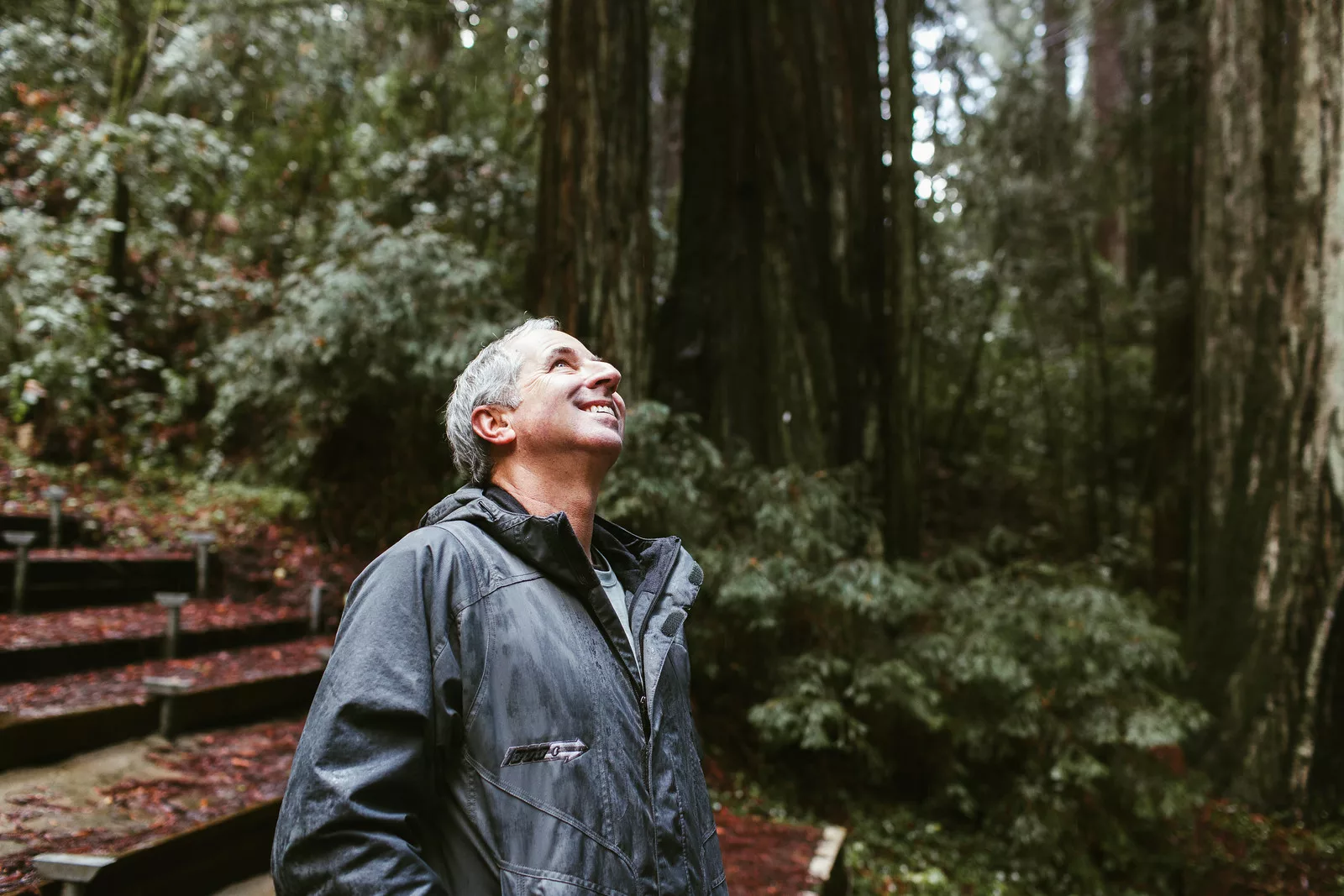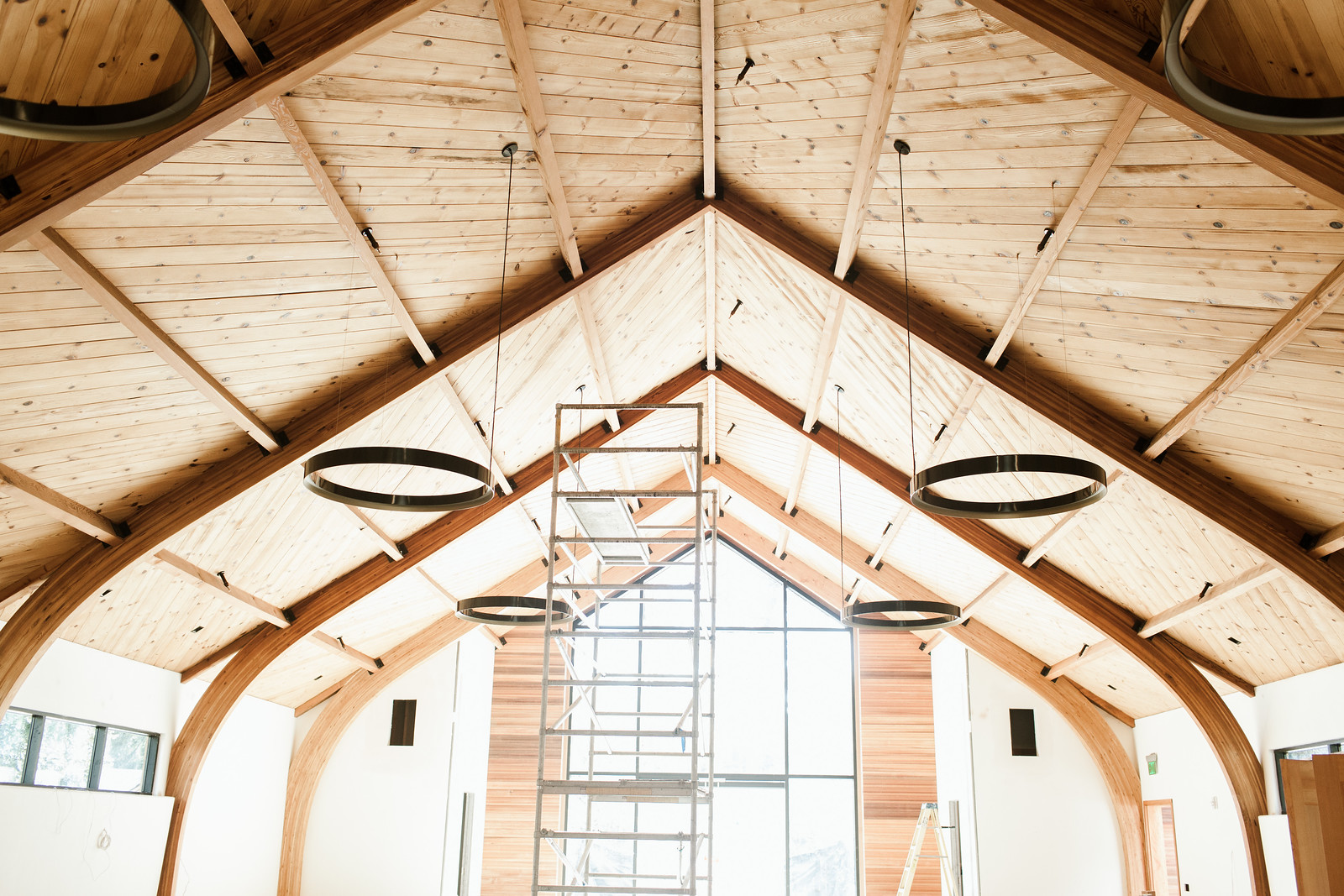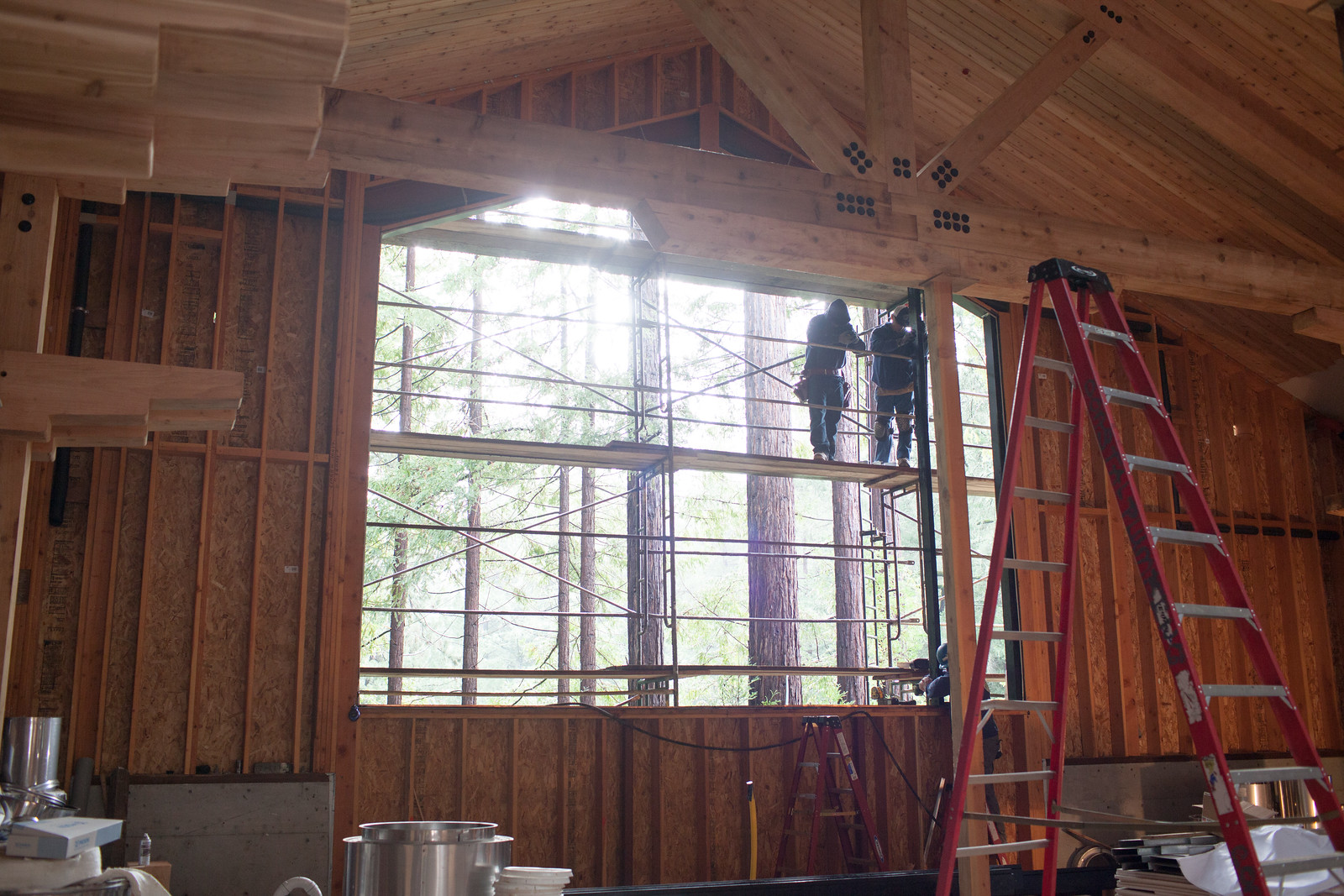After decades as an executive in the tech industry, Scott Kriens resigned as CEO of Juniper Networks in 2009 to follow his passions in the areas of authentic leadership and integrated living. Now his new project, 1440 Multiversity, is scheduled to open in May 2017 as a retreat center offering “teachable skills for better living” programs presented by top names in personal development, health and wellness, leadership, career development, and more. CONSCIOUS COMPANY Chief Expansion Officer Aaron Kahlow caught up with Kriens on a tour of the new Santa Cruz, CA, campus to hear more about how he found a renewed sense of mission in life and what he’s learned about values-driven leadership along the way.
Tell us about your journey to get where you are today.
Scott Kriens: I was born and raised in California. Every once in a while, what you might call “life’s bigger questions” would pop up and I would consistently put them off by saying “I don’t know the answer to any of those things.” I only went to college because it seemed easier than the trade union jobs all my buddies were getting when they left high school.
I ended up in the middle of the tech world at the time networking became a big deal, building infrastructure underneath all these things we now take for granted, like the internet itself. When you address something and click “send,” underneath all of that, somebody has to magically, invisibly keep track of several billion places that might go. That’s what we started doing 20-plus years ago. The world continues to demand more of that at an even faster rate all the time. It’s good to be in a good place at the right time, which is where I was.
I was in the very early days of starting a company called Stratacom that ran for about 10 years and went public. Then, in 1996, I joined Juniper Networks as the CEO and chairman, really just to see if I could do it. In a couple of years, the company went from a handful of engineers to $1 billion in sales. I was CEO for 12 years, from 1996 to 2009, and I’m still Chairman of the Board today.
You’ve obviously made a decision to do more than be a corporate chairman or CEO. How did you come to that moment, to say “it’s time to do something different”? Some people might call it a second act, some people might call it your real purpose. Tell me a little bit more about that piece of the story.
SK: When my dad died in 2004, it was a harsh confrontation with mortality and it brought up questions I could no longer deflect about what matters. I didn’t, nor do I today, claim to have all the answers, but it led me on a journey into, initially, leadership development. The belief I came to form about leadership development is nobody cares what you say until they know who you are. That quest for authenticity and for the skill of building trusted, authentic relationships was formulated a couple of years after losing my dad. It was what I did as a primary mission for most of the rest of the time as CEO.
It planted the seeds for the observation that being in high-quality relationships and being a skilled relationship practitioner is not just valuable in the workplace. It’s a life skill, and it needs to be taught in all domains. The discovery since then was that it’s a very learnable thing. High-quality relationships aren’t just something that happens because you happen to meet somebody you get along with.
What was the path there? Where did you go to get the teachings and grow as a person?
SK: I thought leadership started with authenticity, showing up as who one really is, but it turns out there’s a prerequisite for that: self-awareness. Because I can’t show up as who I am if I don’t actually know. Stepping back from the intention of authenticity to self-awareness led me to study with a Buddhist monk and find contemplative practices.
How would you define “contemplative practices”?
SK: I use that term because it can be a lot of things. It can be meditation and mindfulness practices, it can be prayer and Christianity, it can be dance. There’s no particular denomination required. It’s the intention of setting aside quiet time. I do that in the form of meditation and journaling.
The question is, “What matters?” While I don’t claim to know, I’m pretty sure the answer isn’t on the outside of us. It’s on the inside of us, or at least it originates there. That notion of “living from the inside out” was very different for me. I spent 45 years basically ignoring the inside, and instead working from the outside in — backwards, I would say today. So for me, meditation, journaling, ultimately everything is a mechanism for learning to live from the inside out. And spending time inside is a requirement if one’s going to do that.
Eventually, my time as a CEO over 12 years and 40-something quarterly earnings calls in a row became a little repetitive. In retrospect, not because any particular occupation or practice is more or less appropriate to an authentic, mindful, relationship-based life; I just wasn’t in a balanced place where I could get both feet back on the ground after being knocked flat when my dad died. There are mindful practitioners doing everything, so it isn’t that you can’t do it as a CEO. It was just that I wasn’t able to do it in that role at that time in my life.
So what did you do? Did you just quit? Did you take a sabbatical? How did that change unfold?
SK: It took me five years. My dad died in January of 2004 and I was the CEO until 2009, because I spent the first couple years denying that this question of “what really matters” needed all that attention, and the last couple years trying to find a succession solution that I was comfortable with for the company. I have two children; the company is like a third child to me, having been now 20 years a part of it.
Ultimately, for me, the change was driven by — almost desperation and inability to continue the life I was leading without some stark realignment. It would be wonderful to think that these changes or growth edges that we all come to and sometimes cross over are driven by inspiration and vision. But, unfortunately, it seems they’re more often driven by trauma and tragedy and sadness and desperation, which is where my redirect was born from. I just needed things to be different than they were, even without knowing what that meant.
Sometimes it’s what I call “a one-arm trapeze act,” because I don’t think you can undergo fundamental transition by swinging with one hand on one trapeze bar and then reaching over and grabbing the other one and then letting go. Bill Bridges wrote about this in a book called “Transitions.” You have to do it with one arm, which means you let go of the bar and now you’re in mid-air and you’re hanging on to nothing and at some point the ground is approaching. Then either by faith or fate or forces I don’t pretend to understand, a bar comes along.
For me, that was it. I just had to let go of the bar I was on and it wasn’t with any vision for 1440 Multiversity or anything like that. It was just “something needs to be different than it is, and all I appear to be capable of at the moment is to stop doing what I’m doing.”
One of the best descriptions I’ve ever heard of courage is that it’s not the absence of fear, it’s being afraid and doing it anyway. One of the barriers for all of us in making a change is this wish that a path is going to present itself before I have to commit. It doesn’t. That’s why we all in times of desperation and despair. We’re afraid, but we’re so desperate to change that it’s not scarier than the thought of staying put.
What’s the vision behind your current project, 1440 Multiversity? How did this all come about?
SK: My wife Joanie and I started the 1440 Foundation in 2010. There are 1,440 minutes in the day; really quite a lot of time if you can be present. It’s not as fleeting as it seems. The foundation was all about grant-making. We got a great piece of advice when we started:
“First listen and learn, don’t actually do anything. Just support all the people you can find who can tell you all the things they’ve already done in areas you’re interested in.”
To our delight, we found that there’s a whole community of people, quite significant and growing at an accelerating rate, who are believers and practitioners and teachers and learners in how to live more purposeful, compassionate, connected, meaningful lives. We made a number of grants and had the benefit of getting to know people like Jack Kornfield and many others. And then it became time to figure out the next chapter for 1440, and we wanted it to be something that would serve all of this energy we had come upon.
By creating the Multiversity, what we’re really doing is holding a container for this and hopefully becoming a gathering force that will nurture and connect and illuminate. To borrow several labels from Meg Wheatley’s emergence theory, which is the framework we use around how change happens, you name things that are going on, you connect them to one another, you nurture those connections, and then you illuminate that for others to see. We believe that with Multiversity we can bring another container, more nurturance, and another spotlight on the work. The best way to make the greatest impact is to find something that already wants to happen and help it. That’s what we’re doing.
How do you boil down what the Multiversity is all about for people who might attend?
SK: First of all, why come here? What would one do and why would one do it? That comes back to this notion we have of “integrated living.” There are two ways to think about that. It means integrating a personal life and a professional life and a pursuit of one’s own health and wellness into one, more integrated self. I don’t have to be one person at work and a different person at home and set aside my own health and wellbeing because of what I’m trying to do either for my family or for my job. What if you could be one person and you could serve all those in a much more connected way?
That’s one way of thinking about it: integrating the various lives we all live into one. Another way of thinking about it is integrating the classic teachings at school — which address your intellectual self and physical self — with one’s emotional, relational, spiritual self. What can I learn about myself, what can I learn about myself in relation to others, and what can I learn about a meaning or a purpose that’s more thoughtful?
What’s learnable in all of that is how to be in more connected, richer, deeper relationships. There are learnable skills to do that. There are practices of empathy and dialogue and compassion. Think of relationship as the fourth “R” after reading, writing and arithmetic. It’s every bit as learnable as the other three — actually, it ought to be the first one. But you learn it the same way. You’re taught by people who practice and have studied it, and you do it in practices with others, and you evaluate how well you are doing at it, and you try to learn and grow and iterate. It’s not magic and it’s not mystical, but once embarked on, the practice of learning how to be in richer, stronger relationships, whether it’s with self, with others and family, with work, with life — then it’s for each person to discover what’s best for them.
When I was putting this question off for 45 years, it would have been great to come to a place like this not as old as I was and not driven by the trauma that drove me. It would have been better to just come to a classroom setting and start learning about things like this in a nurturing, welcoming way with other people who are interested in the same things, so that I could have stepped into life in a more thoughtful way.
To do that well for 1440 Multiversity means that we have to have offerings that meet people where they are. You might have that desire because of a marriage, it might be with a child, it might be in wanting to be a better leader at work, it might be in wanting to take better care of yourself. They’re all doors into the same space. The one that you should go through is the one that you’re most compelled by, not the one anybody else might advise you to go through.
What kind of advice can you give this Millennial generation, which seems to have a great need for purpose and meaning?
SK: The most important thing is to put time into it. Don’t just make a cocktail conversation out of it or some way to pass time in the middle of your workouts. Growth is a commitment that takes time.
Speaking generationally and being much older, there was a time when it was all about free love and communes and so forth, and then it swung all the way back to “every man for himself,” and now it’s swung back into a place in the middle. The blending of personal motivation and drive with the benefits enabled by community is an opportunity to have more, do more, be more than just “lost in the ’60s” or “on your own in the ’80s.” But you have to put time into it. It has to be a serious commitment like anything else. There’s no magic. It’s one thing to muse about these questions and to ponder them. It’s another thing to really establish a clear intention for self and life.
How does one get to that intention? How do you decide to have an intention?
SK: One of the best pieces of advice I got about it was to skip over the situation you’re in today. Don’t get caught up in having the intention include an understanding of all the steps you’re going to take to get there. It’s a leap of faith. Clear your mind of where you are and how hard it might be and what might prevent it and all of that stuff. Just give yourself the luxury of a purely unencumbered description of your intention. And then work backwards. Don’t try to do it by starting today and figuring out tomorrow or the next day. Start at the end and work back to the beginning.
What’s the call to the fellow leaders in this world? What do we need to do, collectively?
SK: I go back to this principle: nobody cares what you know until they know who you are. And so the first role and responsibility of leadership and development and for cultivating leaders in a corporate setting is to create some time and space for people to get a better grasp of who they are first. And then teach the requirement to put yourself out there before you ask anybody to believe or do anything.
So you do the work first. Before you implement your mindfulness program, the leader must have at least had the experience behind it.
SK: One of the ways we say it is “leaders have to be first to offer.” People will respond. But if you want that energy, if you’re the leader, you can’t wait for somebody else to offer it first. And, in my experience, it’ll always be recognized and be responded to and you’ll be rewarded.
What you’re building in that interaction is trust. Trust is the central element to success in the workplace. It’s the largest contributor that I know of to the success of a person, of a team, of a company. But if you want trust to happen, you have to be explicitly intentional about establishing it, not incidentally hoping it will occur by virtue of your good acts. You have to call it out and you have to be purposeful about establishing it and you have to be the first to demonstrate it. It’s a very rewarding thing to do, and it works. It’s also the most effective way to produce a high -performance team and get a high-performance result.
Trusting teams iterate faster because they’re more willing to admit mistakes and to call out problems and challenges and ask for help. And if two teams are equally smart, why would one team do more than another? It’s because they iterate faster. They learn faster. Well, why do they do that? Because they trust each other to point out the things they’re discovering, and the discoveries come more quickly and they become more clearly understood and they become a part of the next thing you can do, while the team that doesn’t have that is worried and doubtful and hesitant and guarded. And it can get much more toxic than that.
This is not rocket science. Building trust is not just some abstract thing to put on a poster on a wall and then go do something else. It’s actually the prerequisite to success. If you say that and know that, then the next question would be how do you do that? To do it, you better offer it up first. How do you do that? You better know who you are and you better be ready and willing to put that out there. There’s nothing mysterious about it if you stare at it.
What is it we need to do now in the current political era? How do we need to cultivate community?
SK: Seek out and spend time in authentic relationships. And the definition of “authenticity” is when someone is telling you something that they believe as opposed to something that they want you to believe. If we spend our time authentically and share what we believe, and spend our time with other people who we can help along that path, or participate in a community that behaves that way, then we’re going to be fine. Personally, I think this country is far more resilient than any one person, no matter what seat they sit in, can really do a great deal of harm to. But that requires that what is authentic and what is real is cultivated. If anything, if we see the absence of that being more prominent, it should just serve as a call to action. History may write down as being the most valuable contribution you could’ve asked for to this thing we’re talking about.
What’s one of the biggest mistakes you’ve made, and how did you learn from it?
SK: Almost every big mistake I’ve made has been a byproduct of not acting. Seeing somebody that needs help and walking by them. Looking the other way. Having a choice to make, and instead of choosing one or the other, making no choice at all.
An example is bad behavior in people working for me that I haven’t confronted. I rationalize it by thinking what I’m doing is giving people the benefit of the doubt. But what I’m really doing is turning my head and looking the other way. The consequence of that is to allow something to continue that I later know, after I change it, that I should have changed a long time ago. I’ve never made a move to change things that I’ve thought I did too soon. I’ve made a thousand of them long after I should have.
We’ve heard that from other leaders of big organizations, almost the exact same words.
It’s a common shortcoming.
Why is that, though? What’s the human deficiency that allows us to not get better at that?
SK: It’s because of what we want to be true replacing what actually is true.
So it’s our own projections.
SK: “It would be better if all this worked out and I didn’t have to confront it and do anything. It would be better if I were wrong about what I see.” But for the most part, we usually aren’t, especially after seeing it 50 times and telling ourselves 50 times that there’s probably some reason it’s okay.
In my opinion, only maybe 30 percent of the right outcome is a consequence of making the “right decision.” And the other 70 percent of getting there is about making the decision right once made.
“You miss 100 percent of the shots you don’t take.” So take the shot, and if it doesn’t turn out to be what you thought, which is almost certainly going to be true, then adjust and take another one.
What about in other business leaders? Where do you just want to say, “Guys, please just stop,” in a nice and compassionate way?
SK: I think we get a lot further by finding the things we’d like to reinforce than we do with the things we’d like to stop and change. But if anything — and it goes with my compass always pointing at authenticity — it’s to stop thinking people can’t see what you’re doing. Stop thinking you’re smarter than anybody else, because we all know. If you’re trying to make us believe something you don’t really believe and you think we don’t know you’re doing that, stop. Because we do.
Telling a story versus telling the story.
SK: Tell your story.
That’s a good one. What gives you hope? What makes you feel good about the future?
SK: In my little world, it’s all of the people and forces and energy that have come to help with the creation of 1440 Multiversity. Our intention and aspiration is to lead generative lives, and by that we mean lives that create more energy than they consume. And what’s happening at the Multiversity is a generative thing. There is far more energy coming out of this whole adventure than what all of us collectively are putting into it. That gives me hope.
There are times in your life where you can work incredibly hard and sleep very little and wake up with more energy to do it the next day. That’s generative. It is possible to create more energy than one consumes. Imagine that. What could that lead to? It gives me a lot of hope.
And the construction noise we hear in the background means you’re still in the finishing stages of construction?
SK: We’re putting the finishing touches on a three-plus-year effort to build, rebuild this place.
You must be tremendously excited at this stage.
SK: It does create a lot of energy to be here.
I hear anxiety in that energy as well.
SK: It’s all going to work out fine.









